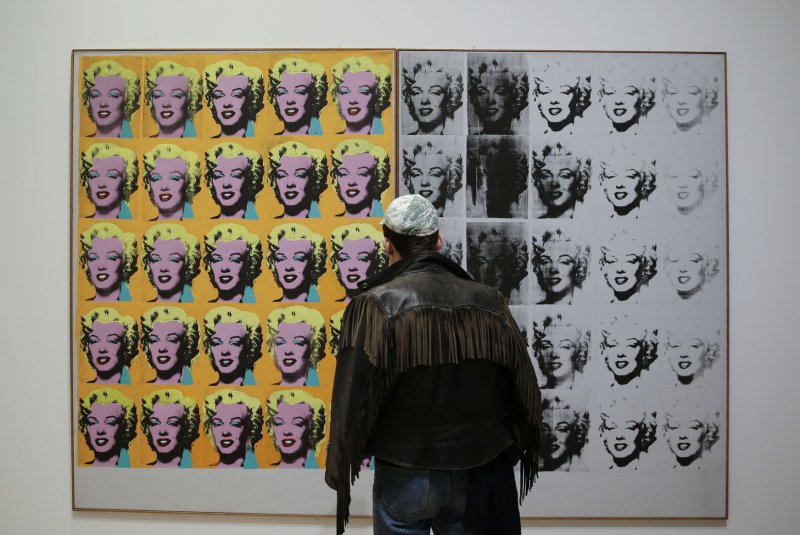People stand among works of art by Andy Warhol depicting Marilyn Monroe at the Whitney Museum of American Art in New York City in 2018. File Photo by John Angelillo/UPI |
License Photo
March 28 (UPI) -- The U.S. Supreme Court on Monday said it would hear a copyright case stemming from Andy Warhol silk-screen prints of Prince that were based on a portrait of the singer taken by renowned photographer Lynn Goldsmith.
Goldsmith, known for taking portraits of famous rock musicians, had taken the portrait of Prince in 1981. When Prince released his album Purple Rain three years later, taking him to mega-stardom, the magazine Vanity Fair spent $400 to license Goldsmith's photo for use as an artist's reference.
Vanity Fair then commissioned Warhol, the artist known best for appropriating images from pop culture such as Campbell's soup cans and portraits of Marilyn Monroe, to make a silk-screen print based on the photo of Prince, according to documents filed to the Supreme Court.
Goldsmith said in court documents that she was unaware that the image was to be used by Warhol and that the artist would continue to use her photograph to create a total of 16 works, including paintings and drawings, known collectively as the Prince Series.
When Prince died in 2016, Condé Nast magazine used one of Warhol's prints based on Goldsmith's photo on the cover of its issue paying tribute to the late musician. Warhol died in 1987.
Goldsmith then threatened to sue the Andy Warhol Foundation, which had assumed the copyrights to Warhol's work. Before Goldsmith could sue, the foundation filed its own lawsuit against Goldsmith seeking a declaration of non-infringement.
A countersuit was then filed by Goldsmith seeking a permanent injunction to prevent the foundation from further reproducing and selling Warhol's work in the so-called Prince Series.
In July 2019, a federal district court judge ruled in favor of the Andy Warhol Foundation on its claim of fair use, finding that the Prince Series was "transformative" because Goldsmith's image depicted Prince as "not a comfortable person" while Warhol's portrayed him as an "iconic, larger than life figure."
The U.S. Court of Appeals for the Second Circuit in New York reversed the lower court's decision last year and ruled in favor of Goldsmith, stating that "whether a work is transformative cannot turn merely on the stated or perceived intent of the artist."
"We conclude that the Prince Series is not "transformative" within the meaning of the first factor," the appeals court wrote in its opinion. "That is not to deny that the Warhol works display the distinct aesthetic sensibility that many would immediately associate with Warhol's signature style -- the elements of which are absent from the Goldsmith photo."
The Andy Warhol Foundation then petitioned the Supreme Court to intervene, arguing that the case presents questions about the seemingly ambiguous definition of being "transformative" that "threatens a sea-change in the law of copyright."
"This petition raises a question of exceptional importance regarding the scope of the Copyright Act's fair use defense," the Andy Warhol Foundation wrote in its petition.
"The Second Circuit's decision below creates a circuit split and casts a cloud of legal uncertainty over an entire genre of visual art, including canonical works by Andy Warhol and countless other artists."
In her response to the foundation's petition, Goldsmith said that the case "does not warrant" Supreme Court review.
Goldsmith's response states that the Andy Warhol Foundation's petition "mischaracterizes" precedents already established by the Supreme Court and the Second Circuit's opinion "to manufacture a circuit split that does not exist."
She noted in her brief that Warhol's assistant, Gerard Malanga, admitted in an interview after Warhol's artwork prompted previous copyright-infringement lawsuits that his work "was not to get away from the preconceived image but to more fully exploit it.
Goldsmith has also photographed artists including Michael Jackson, Bruce Springsteen, Bob Dylan, Madonna, James Brown, the Beatles and the Rolling Stones and has been featured on more than 100 album covers.















